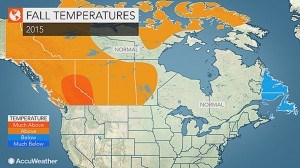
Low temperatures and early snowfalls in the mountains have made for a relatively cool start to the fall, but don't expect those chilly days to stick around.
Fall temperatures are expected to be well above normal with precipitation levels forecasted to be below normal, according to Accuweather, an American company that provides weather forecasting services across North America.
“When we look at the fall forecast we are fairly confident that temperatures across western Canada, which includes British Columbia and Alberta, will be above, to well above, normal for the fall,” said Brett Anderson, senior meteorologist for the company.
“Obviously we've had some snow already and I think there are more opportunities for snow during the month of September, however once we get into October and November we think the pattern will go into a warmer than normal pattern throughout much of the region.”
He said a ridge of high pressure anchored along the west coast will likely keep cool, chilly air to the north and keep southern B.C. and southwestern Alberta dryer than normal.
The news doesn't bode well for Alberta farmers who are dealing with a severe drought.
In August, Alberta declared a province-wide agricultural disaster as a result of extreme weather conditions and drought.
According to media reports, the government-run Agricultural Financial Services Corporation said it expects to pay out close to $1 billion in insurance claims to the 80 per cent of farmers struggling with drought this year.
It was also one of the worst wildfire seasons on record for B.C., Alberta and Saskatchewan, with 491,000 hectares burned in Alberta alone.
According to the province's most recent fiscal update, disaster assistance spending jumped by $456 million to $757 million as result of agricultural losses and wildfires.
Looking ahead to winter, Anderson predicts El Niño will also have a major impact on weather patterns across North America.
“We believe the El Niño will be one of the strongest El Niños, top five if not a top three, in recorded history and that certainly will have an influence on western Canada during the winter time.”
He also said warm water off the west coast is going to play a factor this winter.
“The combination of both of those factors should certainly argue for temperatures above to well above normal throughout the winter time across western Canada.”
Predicting the amount of precipitation is a bit more difficult because when there is a lot of warm water off the coast there is a greater chance of moisture in the air, which energizes storms.
“Even though we think most of the storms will end up tracking up into Alaska, the storms we do get coming into western Canada could actually be stronger then they typically are, producing heavier snowfall and heavier rainfall across the region,” said Anderson.
In addition to current weather patterns, Anderson said the impacts of climate change can't be ignored and must be factored in when predicting future weather patterns.
“Canadian winters have progressively been getting warmer over the past 40 to 60 years,” said Anderson.
“Not even looking at what the overall pattern is this year, right off the bat the odds favour it being above normal probably six or seven out of 10 times,” he said, explaining the loss of snow cover in the far north and increased ocean temperatures play a major factor.
Part of the reason temperatures are considered above average is because “normal” Canadian temperatures are based on climate data from 20 or 30 years ago.
In Jasper, for example, the average temperature in the middle of October is 10 degrees, but that is based on data from the 1980s and 90s, explained Anderson.
“Nowadays, in this century, [the average temperature] is probably more like plus 11 degrees, maybe even a little bit higher than that, so when you're including those earlier years it doesn't take much to be above normal,” said Anderson.
To create long-term weather forecasts, Accuweather looks at ocean temperatures and patterns, uses analogs to compare and contrast historical weather patterns and utilizes long-range computer models.
Anderson said about 90 per cent of the computer models considered for this year are showing a warm winter across western Canada.
“I've been doing this for many years and I have not seen this much agreement for a warm winter.”
Paul Clarke [email protected]
